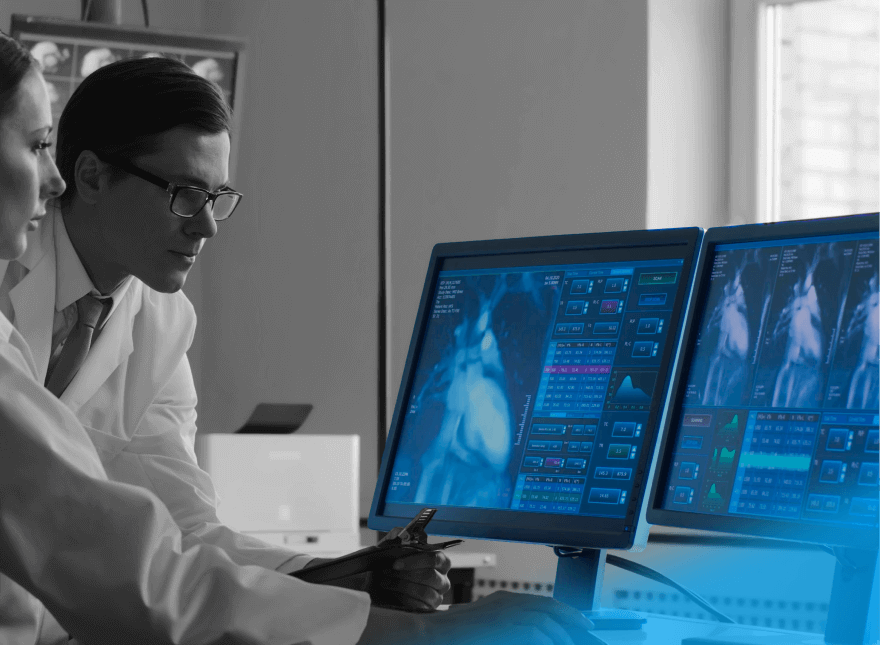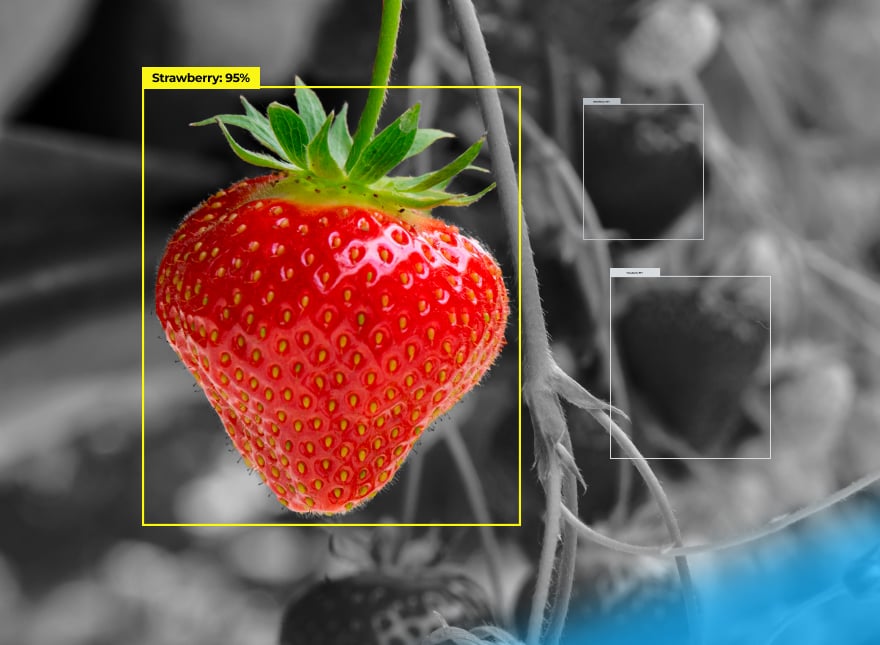How OTA Technology Helps Update Connected Cars On the Fly

The automotive industry is going through a massive digital transformation. In 2023, over 76 million vehicles for sale worldwide will be connected, each of them communicating with other cars and systems using cellular connectivity. Can you imagine the close-future demand in keeping all these cars up-to-date? Regular over-the-air (OTA) updates containing new settings, configurations, and even new services will be a vital part in maintaining the entire system. Let’s see how it becomes possible.
Table of Contents
Over-the-Air Update: What it Is and How it Works
OTA technology allows for updates of applications, services, and configurations over a cellular network—without physical contact, over the air. From a business perspective, over-the-air updates let IoT solutions stay longer in the market without recalling devices.
On the tech side, to enhance software functionality, fix bugs, and patch vulnerabilities, developers simply have to upload updates to the device management system, which sends these updates to all the devices remotely. Besides cellular connectivity, the OTA mechanism supports multiple connectivity types, including Wi-Fi and broadband.
A single OTA update can replace the existing software with a new package. IoT solutions can get two types of updates:
- Firmware over-the-air (FOTA) updates. The technology makes it possible to fix bugs, improve system’s functionality, and upgrade firmware versions without intruding on a device. For example, advanced driver assistance systems (ADAS) inside connected cars need these downloads to update electronic control units (ECUs) remotely.
- Software over-the-air (SOTA) updates. SOTA enables sending, downloading, and installing files to connected devices. These include software updates, security patches, and new functionalities—all with no physical contact. For example, smart heating in connected homes or navigation maps in connected vehicles both can benefit from such updates.
The updating process itself is secured with the rollback-recovery algorithm. So, in case of failure or interruption, the system will be able to restore to its previous state.
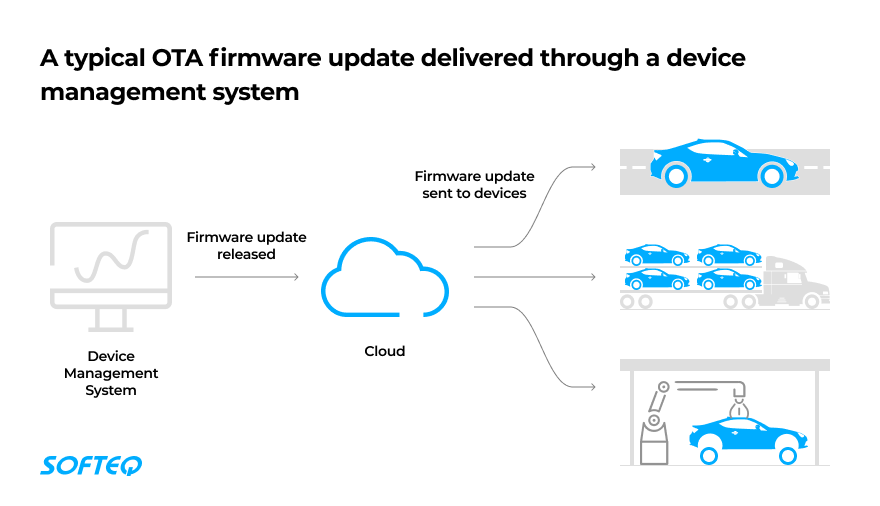
Connected Vehicle Ecosystem: The Need to Be Updated
Because of their numerous features, connected cars have to support a set of applications. For example, ADAS and autonomous driving features are dependent on software and require regular SOTA upgrades. In addition, the more in-vehicle systems that a car has, the more electronic control units (ECUs) must be incorporated. The amount of ECUs per car can now reach 100 and more, and each item requires systematic FOTA updates, among other needs.
Another aspect is a huge need for regular data exchange. Incredibly, in-vehicle systems generate more data than all smartphones and consumer IoT devices: about 258TB altogether daily. These mainly include data generated by numerous sensors about travel routes, speed, components’ wear and tear, and so on. Also, multiple recognition sensors like cameras, radars, and ultrasonics allow cars to сommunicate with traffic lights, parking facilities, pedestrians, and other vehicles.
Here are the major types of vehicle-to-everything connectivity that trigger data streaming:
- Integrating with navigation systems
- Connecting to various types of traffic infrastructure
- Relating to public transport systems
So, vehicles constantly connecting to external systems need to update their software to ensure all communications are smooth and relevant. Software updates let car developers add new functionality, improve security vulnerabilities, and comply with current standards. OTA solutions help their clients update and manage the vehicle-related software without visiting a service center or car mechanic.
Pivotal Aspects of OTA Updates: Benefits for Automakers
So, lack of OTA mechanisms in a hardware-defined system will require visits to a service center—to improve telematics, diagnostic, or infotainment systems. Otherwise, over-the-air updates for cars bring a variety of efficiency and convenience benefits. They cover security patches, infotainment improvements, and core functionality monitoring, like powertrain and vehicle dynamics. Let’s take a look at the benefits that over-the-air updates bring to carmakers and their clients.
Monitoring existing software and adding new features
The OTA mechanism allows car manufacturers to consistently maintain in-vehicle software in all cars—whether still in the dealership or already on the road, and all from a single interface. It’s also convenient to update systems that don’t need additional hardware, such as adding new features and configurations. BMW is among car companies offering map updates over the air.
Fixing vulnerabilities
The variety of in-vehicle software solutions opens the door to cybersecurity breaches, malicious attacks, and data theft. Some safety-critical systems like accelerating, steering, and braking are software-dependent, and OTA updates are here to help immediately address vulnerabilities.
Preventing vehicle recalls
The number of vehicle recalls in the U.S. because of software more than tripled between 2009 and 2019. For instance, within its first year, the 2019 Porsche Cayenne had three software recalls, affecting more than 58 thousand vehicles.
Here are the top 5 types of software recalls in the industry:
- Instrument panel
- Brake ECU
- Engine Control Module
- Transmission ECU
- Body ECU
OTA promises to reduce the number of software-related recalls, and there is already living proof. Tesla became the first automaker that offered over-the-air updates via 3G and WI-Fi for its Model S in 2012. And when Mercedes-Benz recalled 1.3 million vehicles this year, they offered a fix for the faulty emergency location tracker either through a dealer or with an over-the-air update. Today, many other OEMs like BMW, Volvo, Ford, and Volkswagen improve vehicle functionality by pushing software updates over the air.
Decreasing operational costs
Over-the-air technology, with its streamlined software updates and fixes, reduces operational costs. The auto-industry data consulting company IHS Automotive estimates that the total cost savings for OEMs from over-the-air updates will hit $35 billion in 2022 (up from $2.7 billion in 2015). In particular, OTA helps save budget spent on dealing with recalls. According to the Stout Risius Ross report, software issues account for 15% of the automotive industry recalls.
Enabling autonomous driving capabilities
OTA is also a pivotal element of autonomous driving technology that ensures smooth and secure navigating and routing. These updates provide terrain level data and road sign updates, as well as information about currently closed roads and road repairs, so cars with automation features definitely require updates on the go.
Today, only some vehicle models have Level 1, Level 2, or Level 3 degrees of automation. But OTA is here to contribute to the development of more autonomous cars. Today, Tesla Autopilot and Cadillac Super Cruise incorporate level 2 partial automation systems. Honda Motor launched the world’s first level 3 autonomous driving car in March 2021. This luxury sedan Legend system automatically accelerates, brakes, steers, and reads its environment, using data from high-definition maps and external sensors. Experts predict level 4 and level 5 vehicles are on the way in the next 5-10 years. So, with OTA technology, higher levels of driving automation are achievable.
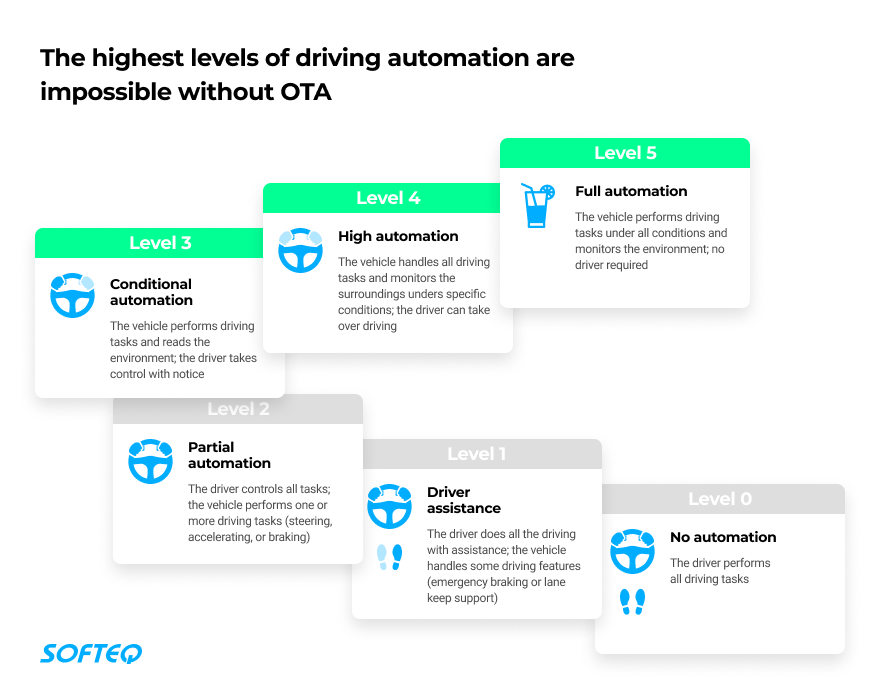
The Society of Automotive Engineers (SAE) created these six levels of driving automation, which have been adopted by the U.S. Department of Transportation.
Meeting new standards and certifications
All vehicles are becoming more and more connected, demanding a new legal framework for their advanced and autonomous features. And governments and organisations are here to support them with novel legislation and standards. The National Highway Traffic Safety Administration (NHTSA), which has the authority to regulate tires, brakes, seat belts, and airbags, also requires the possibility to initiate recalls if any vehicle defect affecting safety is detected. The OTA mechanism, in turn, helps automakers comply with the evolving responsibilities faster and at a lower cost.
Security Concerns
The other side of the story is new security threats and privacy concerns associated with the connectivity of cars. Remote updates increase the chance of malicious attacks on vehicles, including compromising core functions. Tampering with update packages containing information for ECU software upgrades is one of the common threats.
Tesla presents an old but vivid example of possible hacking. Researchers from Keen Security Lab of Tencent remotely took control of a Tesla Model S by compromising Wi-Fi connectivity. As a response, the automaker introduced the code signing protection into their cars in 10 days pushing updates over the air.
So with OTA, it’s crucial to secure the transfer and storage of update packages and protect authorization and verification mechanisms. Complex multi-step techniques that protect data transfer and validate ECUs are a must. And automakers like Tesla use VPN between the server infrastructure and a vehicle.
Key Takeaways
The OTA technology can be both a blessing and a curse. On one hand, it brings lots of benefits that help keep IoT deployment healthy. Ongoing software updates help manufacturers upgrade vehicle features, ensure smooth service, provide security, improve the product, and stay longer in the field. On the other hand, OTA technology comes with challenges that teach OEMs how to deal with customer expectations, consequences of failures, and delivering secure updates. Need assistance with implementing over-the-air updates in automotive? Turn to our engineering team for consulting services and expert advice at any stage of your product development.
More articles on the topic

